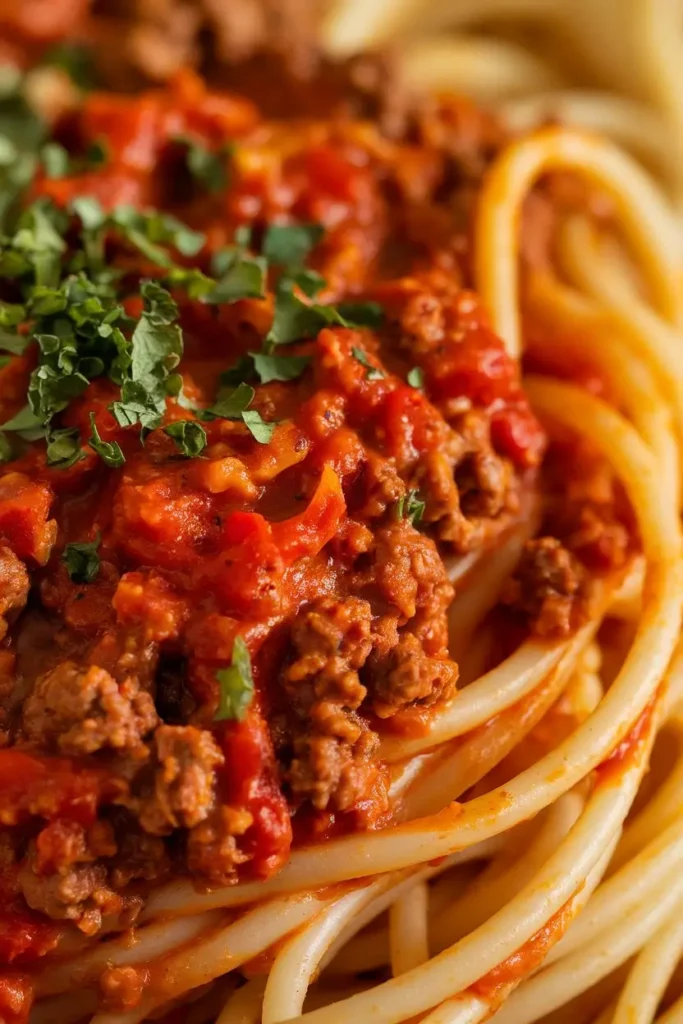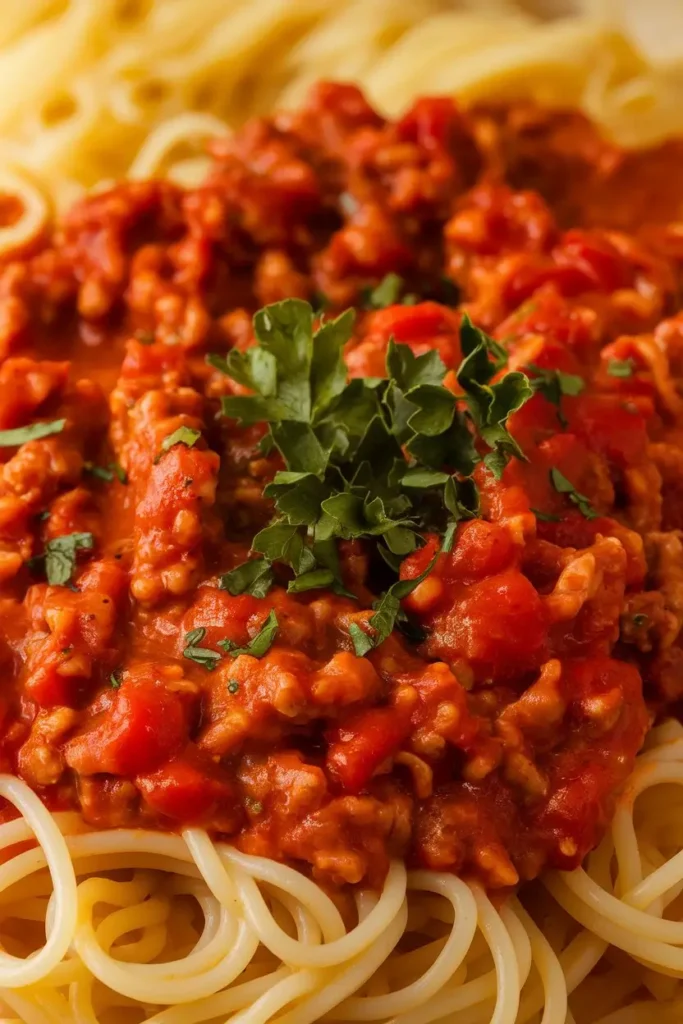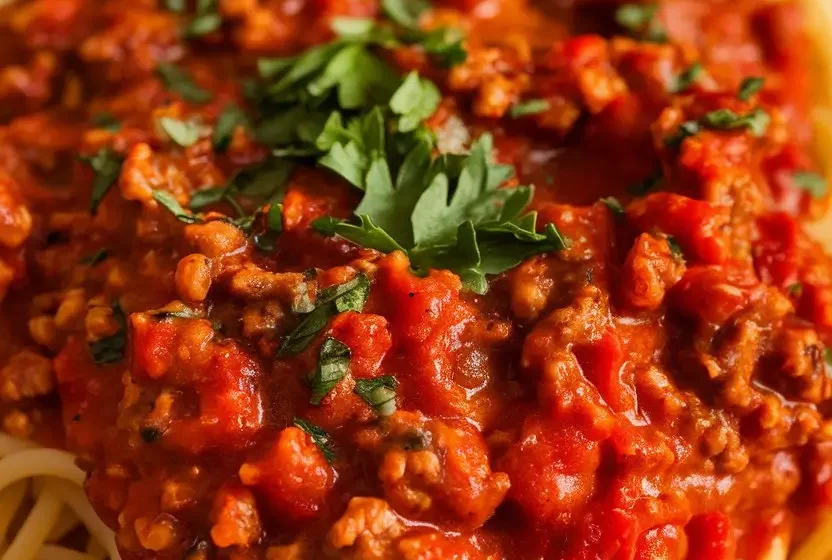What if you could get slow-simmered depth without blocking off your whole afternoon? What if one pan, one pot of pasta, and a few smart tricks turned into the best plate you’ve made this month? If spaghetti and meat sauce is your weeknight staple, you’re about to turn it into a house favorite.
Introduction
If many weeknight sauces clock in at 75 to 90 minutes to reach full flavor, can a 60 minute method really produce the same depth for spaghetti and meat sauce? The short answer is yes, with the right steps. The longer answer is far more delicious.
This version leans on proven technique: aromatic soffritto, high-heat browning, tomato paste for umami, and a quick reduction that mimics a half day simmer. It’s designed to be reliable for busy cooks yet refined enough for a dinner party. With San Marzano tomatoes, a splash of red wine, and a final toss with al dente pasta, the result is rich, balanced, and deeply satisfying.
Along the way, you’ll see why small choices move the needle: salting your pasta water properly, tilting a lid to manage evaporation, and finishing the sauce with starchy pasta water for a restaurant-level coating. This is pasta with meat sauce done right.

Ingredients List
Authentic flavor starts with quality ingredients. Here’s what you need, plus flexible swaps that keep the flavor on point.
- 2 tablespoons extra-virgin olive oil
- 1 medium yellow onion, finely diced
- 1 medium carrot, finely diced
- 1 celery rib, finely diced
- 4 cloves garlic, minced
- 1 pound ground beef, 85 to 90 percent lean
- 1 teaspoon kosher salt, plus more for pasta water
- 1/2 teaspoon freshly ground black pepper
- 1/4 to 1/2 teaspoon crushed red pepper flakes, optional
- 2 tablespoons tomato paste
- 1/2 cup dry red wine
- 1 can (28 ounces) whole peeled tomatoes, preferably San Marzano
- 1 teaspoon sugar, optional, to balance acidity
- 1/2 cup beef stock or water, as needed
- 1/2 cup whole milk or 2 percent milk
- 12 ounces dry spaghetti
- 1/2 cup finely grated Parmesan, plus extra for serving
- 1/4 cup chopped fresh basil or flat-leaf parsley
- Extra-virgin olive oil for finishing
Substitution ideas that still deliver great spaghetti and meat sauce:
- Meat: Swap half the beef for mild Italian sausage or ground pork for a richer ragù. For lighter, use ground turkey thigh or chicken thigh.
- Plant-forward: Replace half the meat with finely chopped mushrooms or lentils for body and umami.
- Tomatoes: Crushed tomatoes work. If using diced, blend briefly for a smoother sauce.
- Wine-free: Use beef or chicken stock with 1 teaspoon balsamic vinegar for complexity.
- Dairy-free: Skip the milk and finish with a splash of olive oil and nutritional yeast.
- Pasta: Whole wheat spaghetti, gluten-free spaghetti, or bucatini all work beautifully.
Timing
This method is fast by classic standards without cutting corners on flavor.
- Prep: 15 minutes
- Simmer and pasta cooking: 40 to 45 minutes
- Total: 55 to 60 minutes
Many popular recipes take 75 to 90 minutes to achieve similar body and sweetness from tomatoes. By toasting tomato paste, reducing wine quickly, and simmering uncovered for part of the cook, you compress time while still building complexity.
Quick benchmark:
- 60 minutes with this method
- 20 percent or more faster than many long-simmer versions

Step-by-Step Instructions
Step 1: Build the aromatic base
Heat 2 tablespoons olive oil in a large, heavy skillet or Dutch oven over medium heat. Add onion, carrot, and celery with a pinch of salt. Cook, stirring, until soft and sweet, 7 to 9 minutes. Add garlic and cook 30 seconds until fragrant. A slow, patient sweat here sets up the entire sauce.
Tip: Keep heat moderate. Browning the vegetables too quickly introduces harsh notes.
Step 2: Brown the meat for real flavor
Increase heat to medium-high. Add ground beef, breaking it up with a spoon. Season with 1 teaspoon salt, black pepper, and red pepper flakes if using. Let the beef sit undisturbed for 2 minutes to brown, then stir. Cook until no pink remains and fond forms on the pan, 5 to 7 minutes. Drain excess fat if needed, leaving a tablespoon for flavor.
Tip: Real browning equals real depth. Steam is the enemy, so don’t overcrowd the pan. Work in two batches if necessary.
Step 3: Toast the tomato paste
Scoot the meat and veg aside. Add tomato paste to the hot surface of the pan. Cook, stirring the paste, 1 to 2 minutes until it darkens to brick red. This step concentrates umami and tames raw acidity.
Step 4: Deglaze with wine
Pour in the red wine. Scrape up all the browned bits from the bottom of the pot. Let it bubble and reduce by about half, 2 to 3 minutes, until it smells rounded and slightly sweet.
No wine? Use stock and a teaspoon of balsamic or red wine vinegar for brightness.
Step 5: Add tomatoes and balance
Crush whole tomatoes by hand in the can or with a potato masher in the pot. Add tomatoes and their juices. Stir in sugar if the tomatoes taste sharp. If the mixture seems tight, add 1/4 to 1/2 cup stock or water.
Taste the sauce now. If it’s tangy, plan to add the milk later to smooth it out.
Step 6: Simmer with control
Bring to a gentle simmer. Partially cover the pot by tilting the lid, and simmer 25 to 30 minutes. Stir every 5 minutes, keeping the heat low enough to blip but not sputter. Remove the lid for the last 5 to 10 minutes to thicken to a spoon-coating consistency.
Tip: If it thickens too much, add a splash of water. If it’s thin, simmer uncovered a bit longer.
Step 7: Add milk for silk and finish seasoning
Stir in the milk and simmer 3 to 5 minutes. This softens acidity, rounds edges, and adds a satiny texture reminiscent of a northern Italian meat sauce. Taste and adjust with salt and pepper. Fold in the chopped basil or parsley.
Optional: A small knob of butter adds a glossy finish.
Step 8: Cook spaghetti to al dente
While the sauce simmers, bring a large pot of water to a rolling boil. Salt the water generously. It should taste like the sea. Add spaghetti and cook until just shy of al dente, 1 minute less than package directions. Reserve 1 cup of the starchy pasta water before draining.
Tip: Salty pasta water seasons from the inside. Under-seasoned water is the most common reason spaghetti and meat sauce tastes flat.
Step 9: Marry pasta and sauce
Add drained spaghetti to the sauce. Sprinkle in a splash of reserved pasta water and toss over medium heat for 1 to 2 minutes until every strand is coated and glossy. The starch helps the sauce cling. Add Parmesan and a drizzle of olive oil. Toss again. Adjust with more pasta water if needed for that silky sheen.
Serve immediately with extra Parmesan at the table.
Nutritional Information
Estimates below are for 6 servings, including 12 ounces dry spaghetti, 1 pound 85 percent lean ground beef, and the ingredients listed. Actual values vary with brands, portion size, and any swaps.
Per serving (approximate):
- Calories: 490 to 520
- Protein: 22 to 25 g
- Carbohydrates: 58 to 62 g
- Dietary fiber: 4 to 6 g
- Total fat: 16 to 20 g
- Saturated fat: 6 to 8 g
- Sodium: 600 to 800 mg
- Sugars: 8 to 11 g
Nutrition table:
| Nutrient | Amount per serving |
|---|---|
| Calories | ~505 kcal |
| Protein | ~24 g |
| Carbs | ~60 g |
| Fiber | ~5 g |
| Total Fat | ~18 g |
| Saturated Fat | ~7 g |
| Sodium | ~700 mg |
| Added Sugar | ~1 g |
| Calcium | ~180 mg |
| Iron | ~4 mg |
Tip: To reduce sodium, use low-sodium tomatoes and stock, and salt pasta water carefully.
Healthier Alternatives for the Recipe
- Leaner protein: Use ground turkey thigh or chicken thigh. Aim for 93 percent lean to keep moisture while trimming fat.
- Plant-forward meat sauce: Combine 8 ounces finely chopped cremini mushrooms with 8 ounces 90 percent lean beef. You keep savory depth with fewer calories and more minerals.
- Whole grain or legume pasta: Whole wheat spaghetti adds fiber. Chickpea or lentil pasta boosts protein. Cook just to al dente to avoid mushiness.
- Extra vegetables: Fold in a packed cup of chopped spinach or kale during the last 5 minutes. Grated zucchini melts into the sauce and adds body with almost no calories.
- Dairy-free creaminess: Blend 2 tablespoons cashew butter with 1/4 cup hot pasta water and stir into the sauce to replace milk and Parmesan.
- Lower sodium: Choose no-salt-added tomatoes, skip added sugar, and rely on herbs and black pepper for lift.
Dietary paths:
- Gluten-free: Use certified gluten-free spaghetti and check labels on stock and tomato products.
- Low-carb: Serve over spaghetti squash or spiralized zucchini and reduce or omit pasta.
- Dairy-free: Skip the milk and cheese; finish with good olive oil and fresh herbs.
Serving Suggestions
Spaghetti and meat sauce can be weeknight-friendly or dinner-party worthy. Shape your plate to match the moment.
- Classic: Twirl a small nest of spaghetti on warm plates, top with extra meat sauce, shower with Parmesan, and finish with basil and a drizzle of olive oil.
- Family style: Toss pasta and sauce in a large bowl and set out sides of grated cheese, chopped parsley, and chili flakes so everyone can customize.
- Lighter plate: Pair with a crisp salad of arugula, shaved fennel, and lemon vinaigrette. The acidity balances richness.
- Bread pairing: Toasted garlic bread or a rustic loaf for sopping. Brush slices with olive oil and rub with a cut clove of garlic for aroma.
- Wine: A medium-bodied red with bright acidity, like Chianti or Sangiovese, complements the tomato base. For a white, try Verdicchio.
- Kids’ table: Cut spaghetti into shorter lengths before tossing and offer mild cheese on the side.
Looking to build a full Italian-inspired menu? Consider a simple caprese to start and roasted broccoli or green beans as a warm side. If you enjoy cooking technique deep dives, check out our guide to making pasta water your secret sauce and our collection of homemade garlic bread ideas.
Common Mistakes to Avoid
- Skipping real browning: Gray meat means less flavor. Give it time to sear before stirring.
- Not toasting tomato paste: Raw paste tastes flat. Two minutes in the pan turns it into a flavor booster.
- Thin sauce: Lid off to thicken, lid on to retain moisture. Manage evaporation to hit that spoon-coating texture.
- Under-salted pasta water: It should taste like the sea. This is your main chance to season the noodles themselves.
- Overcooking pasta: Pull it a minute early. It will finish in the sauce.
- Sauce breaks or tastes sharp: Add milk at the end for silk and balance. A knob of butter helps emulsify if needed.
- Low-quality tomatoes: The sauce is only as good as your tomatoes. San Marzano or a trusted brand makes a difference.
- Dump-and-stir finish: Always toss pasta in the sauce with a splash of pasta water. That’s how you get restaurant-style cling.
Storing Tips for the Recipe
- Cool quickly: Divide hot sauce into shallow containers so it cools fast and stays safe.
- Refrigerate: Store sauce in airtight containers for up to 4 days. Keep pasta and sauce separate if possible to protect texture.
- Freeze: Sauce freezes well up to 3 months. Lay flat in freezer bags or use snug containers. Label with date.
- Reheat: Warm sauce gently on the stove over medium-low heat with a splash of water or stock. Adjust salt at the end.
- Meal prep: Cook a double batch of sauce and freeze in 1 to 2 cup portions. Boil fresh pasta on the day you serve.
- Leftover pasta: If spaghetti is already tossed, add a bit of water in the skillet to loosen as you reheat. Finish with a thread of olive oil.
Quick recap and your next plate
In about an hour, you build a rich, balanced spaghetti and meat sauce with real browning, toasted tomato paste, and a controlled simmer. Try it tonight, rate the recipe, leave a comment with your twist, and subscribe so you never miss new pasta ideas and cooking guides.
FAQs
Q: What’s the difference between this meat sauce and classic Bolognese? A: Traditional Bolognese is milk-forward with a smaller tomato footprint and often simmers for hours. This recipe is tomato-driven with milk for balance, built to deliver weeknight speed with weekend depth.
Q: Can I use fresh tomatoes? A: Yes. Use 2 pounds ripe, peeled, and crushed tomatoes. Simmer longer to concentrate. If the sauce tastes sharp, add a pinch of sugar or an extra splash of milk at the end.
Q: Do I have to use red wine? A: No. Use beef or chicken stock with 1 teaspoon balsamic or red wine vinegar. You’ll get a similar lift without alcohol.
Q: My sauce tastes acidic. How do I fix it? A: Simmer a bit longer to reduce and sweeten naturally. Add milk and a small knob of butter to round edges. A pinch of sugar helps if your tomatoes are very tangy.
Q: Can I make the sauce ahead? A: Absolutely. The flavor actually deepens overnight. Refrigerate up to 4 days or freeze up to 3 months. Reheat gently and refresh with a splash of water and fresh herbs.
Q: How salty should the pasta water be? A: Salty like the sea. Aim for roughly 1 to 1.5 tablespoons kosher salt per 4 quarts of water. That sounds bold, but most of it drains away and it’s key for well-seasoned pasta.
Q: Can I cook this in an Instant Pot or slow cooker? A: Yes. For Instant Pot, brown on Sauté, deglaze, add tomatoes, then pressure cook 8 minutes with a quick release. For slow cooker, transfer browned base and cook on Low 6 to 7 hours. Reduce on the stovetop if needed to thicken.
Q: How do I make it dairy-free? A: Skip milk and Parmesan. Finish with extra-virgin olive oil, plenty of fresh herbs, and nutritional yeast for savoriness.
Q: What if I only have jarred marinara? A: Brown the meat with aromatics, then stir in 24 ounces of marinara and simmer 10 to 15 minutes. It won’t be the same as from-scratch tomatoes, but it’ll still be a solid plate.


